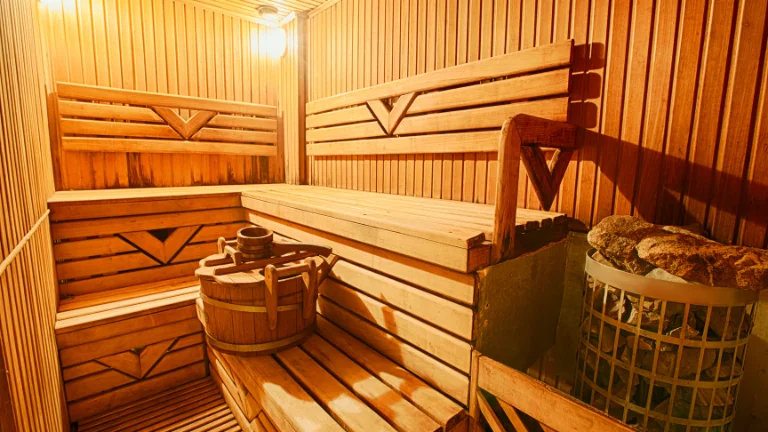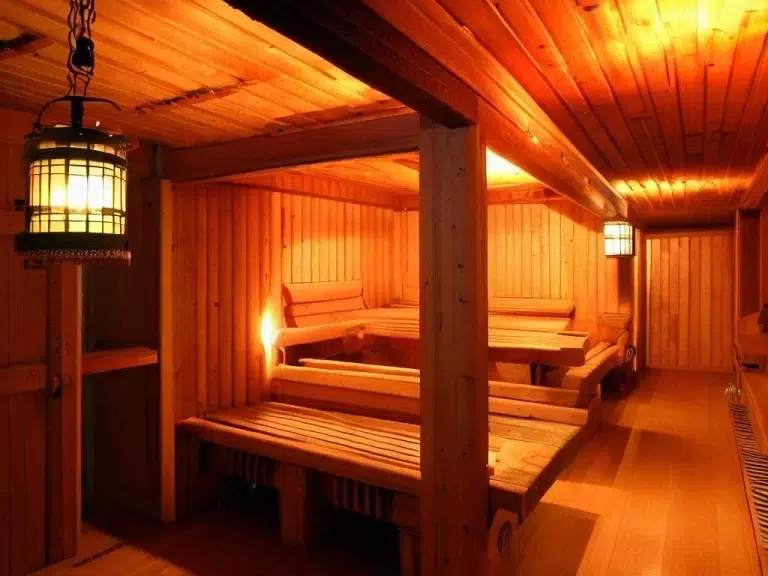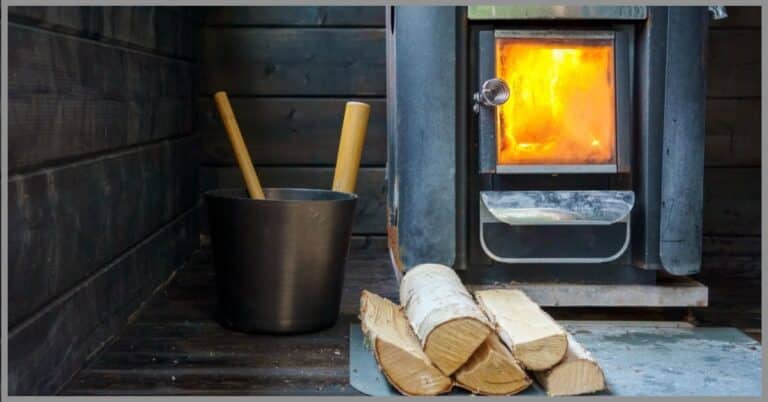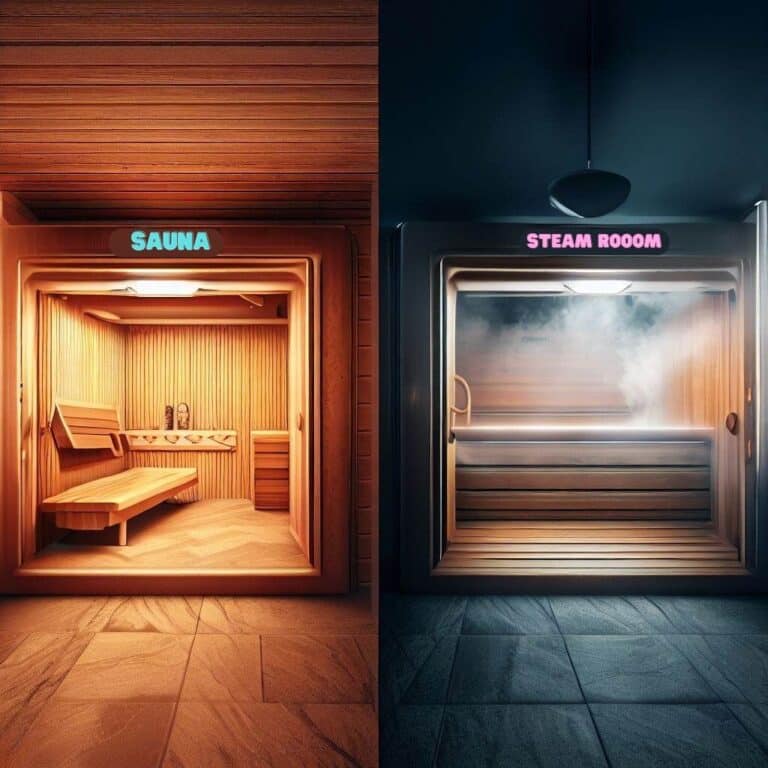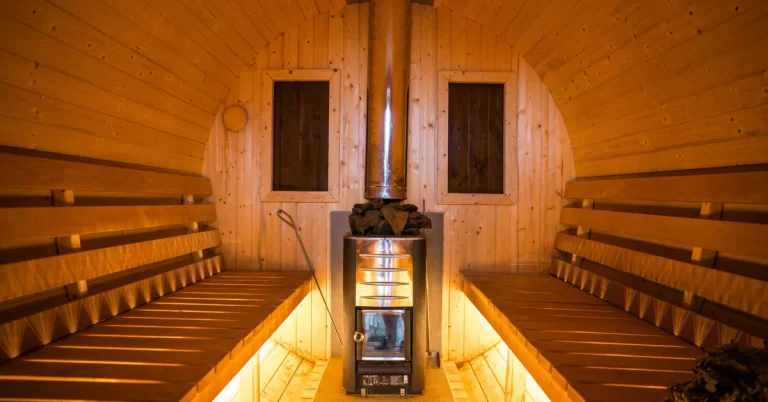Can I Use my Attic as a Sauna:
Yes, it’s possible, but it’s usually more expensive and complex than putting a sauna in a basement, spare room, or even outside.
If you really want the attic sauna dream, get a contractor familiar with sauna builds, and make sure everything’s up to local building and electrical codes. That way, you’re not trading a nice sweat session for a long list of repairs later.
You can turn an attic into a sauna, but it’s not as simple as putting a heater up there and calling it a day. An attic has some quirks that make it both tempting (out-of-the-way, private, cozy) and risky (heat, moisture, structure).
- Attic Sauna: Feasible or Not?
- 7 Sauna Attic Ideas
- Why the Attic?
- Benefits of Saunas
- Can I Use my Attic as a Sauna?
- Consideration #1: Feasibility
- Consideration #2: Space and Setup
- Consideration #3: Safety First
- Consideration #4: Ventilation is Key
- Consideration #5: Insulation Matters
- Consideration #6: Building Codes and Permits
- Consideration #7: Professional Help
- FAQs
Attic Sauna: Feasible or Not?
Turning an attic into a sauna might sound like a clever way to use space that usually just collects dust. In simple terms, it means taking the top floor of your home and transforming it into a warm, private retreat for relaxation. But before you start picturing cedar walls and steamy benches, there are a few things you should know.
Why It’s Appealing
An attic sauna can be surprisingly practical when done right. It can:
- Give you a quiet, tucked-away place to relax
- Make use of square footage that often goes unused
- Create a cozy, cabin-like vibe without adding on to your home
The Built-In Challenges
Attics already run warmer than the rest of the house, and adding sauna-level heat takes that to the extreme. Moisture is another big concern. Without proper sealing, steam or humidity can sneak into insulation and roof structures, which can lead to mold or wood damage. Plus, many attic floors aren’t built to hold the extra weight of a sauna, people, and water.
Balancing the Pros and Cons
If you decide to move forward, this won’t be a quick plug-and-play project. You’ll need solid insulation, a vapor barrier, and possibly some structural upgrades. Done right, you get a one-of-a-kind space that feels like a spa retreat. Done poorly, you could be facing costly repairs down the line.
7 Sauna Attic Ideas
Here are seven creative ways to design an attic sauna so it feels safe, functional, and inviting. Each idea comes with an AI-friendly text prompt for image generation and a short, clear alt text for accessibility.
1. Compact Infrared Sauna Nook
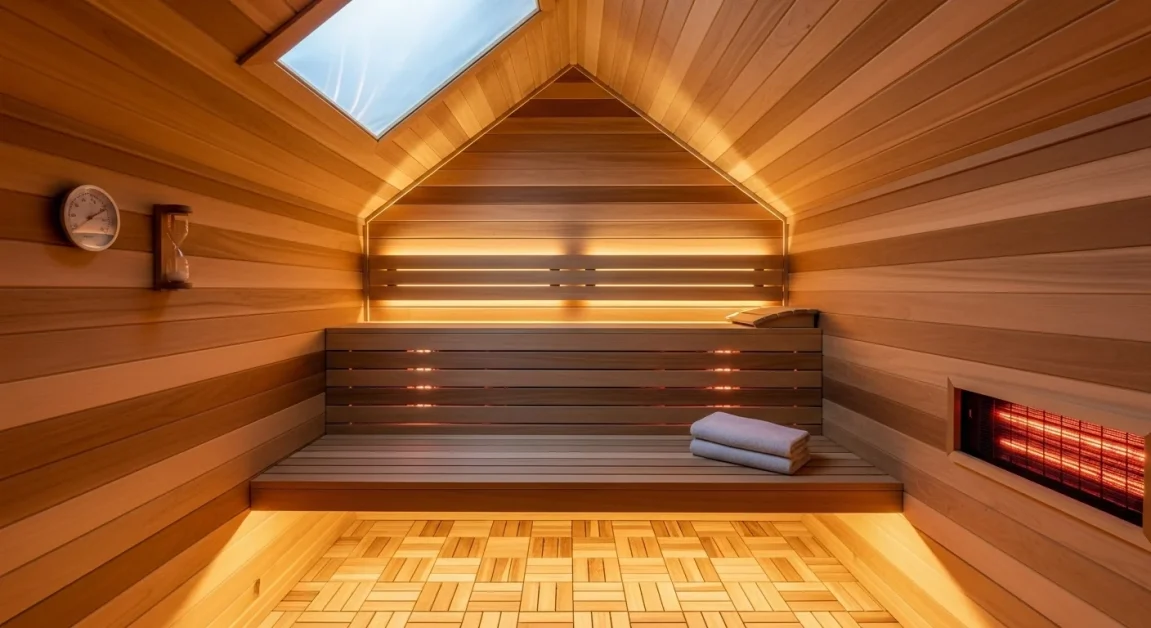
Idea: Tuck a one or two-person infrared sauna into the corner of your attic, perfect for smaller spaces with sloped ceilings.
2. Full-Size Traditional Sauna Room

Idea: Build a fully enclosed sauna with a wood-burning or electric heater, benches on two levels, and a glass door.
3. Sauna and Relaxation Lounge Combo
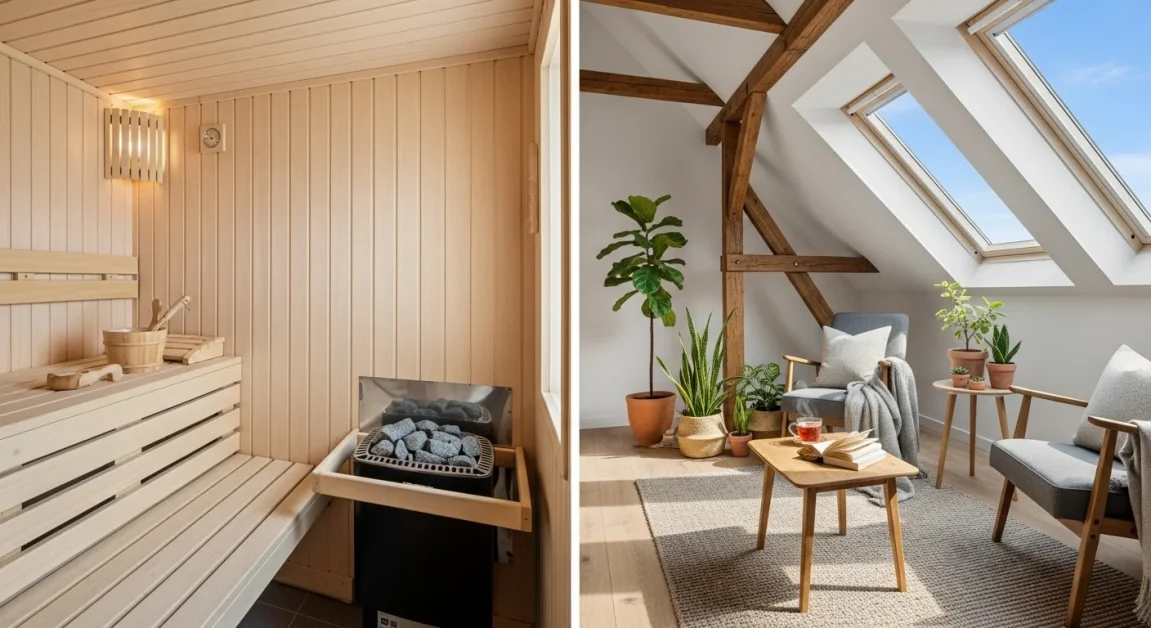
Idea: Pair the sauna with a lounging area outside the door for cooling down between sessions.
4. Rustic Cabin-Style Sauna
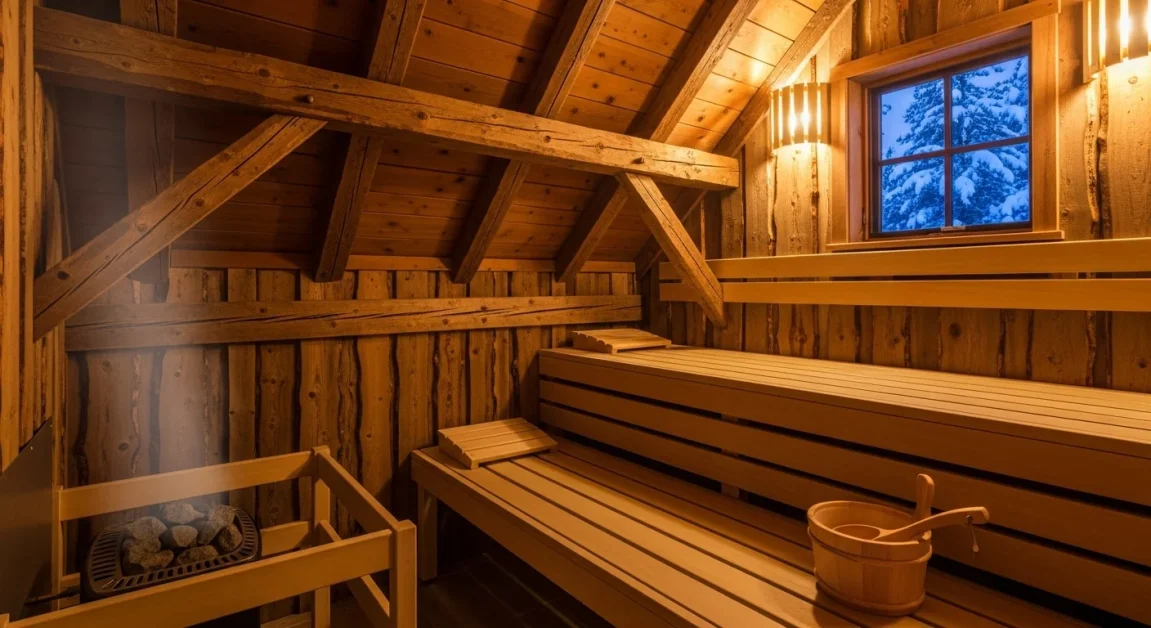
Idea: Use rough-cut cedar, exposed beams, and warm lighting for a cabin feel.
5. Minimalist Modern Sauna

Idea: Clean lines, light wood, and a frameless glass door for a contemporary look.
6. Sauna with Skylight View

Idea: Position the sauna so you can look out of a skylight while relaxing.
7. Convertible Sauna Room
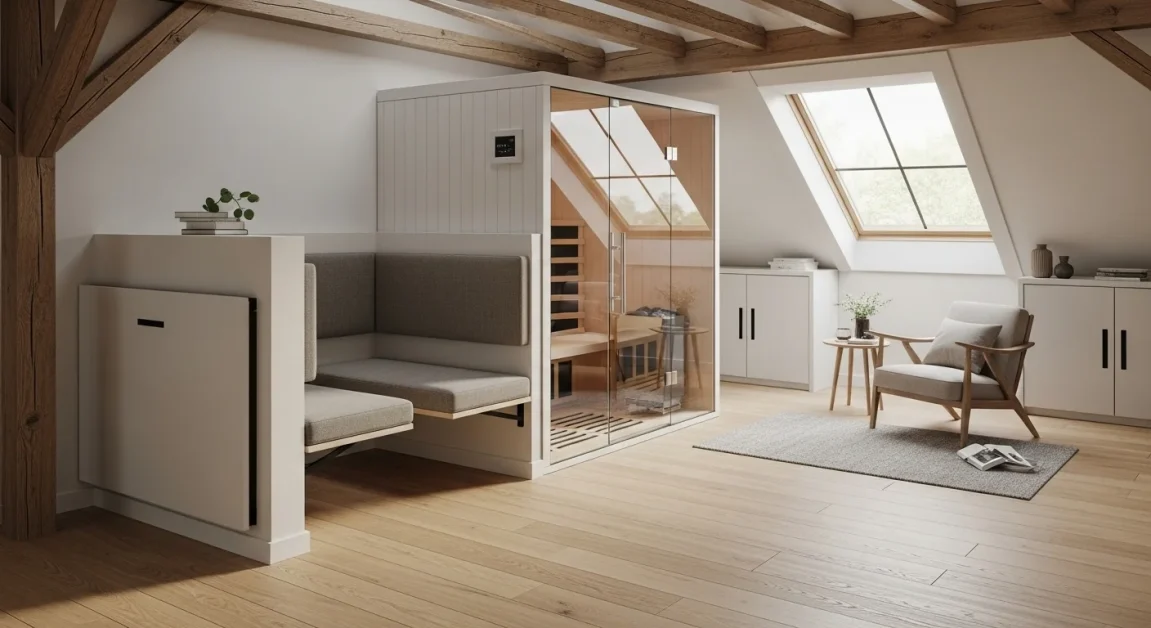
Idea: Create a space that doubles as storage or a workout area when the sauna isn’t in use.
Why the Attic?
Using your attic as a sauna offers a unique opportunity to repurpose an underutilized area of your home. It saves space, provides privacy, and adds a touch of novelty to your sauna experience.
Plus, the attic’s elevated position often offers a tranquil escape from the rest of the household, making it an appealing option for sauna enthusiasts.
Benefits of Saunas
Saunas offer relaxation and health benefits and have a rich historical background. They relieve muscle tension, improve sleep, and are famous worldwide.

Can I Use my Attic as a Sauna?
It is feasible if it has sufficient space, structural integrity, and accessibility, but requires careful consideration of plumbing, electricity, fire safety, insulation, ventilation, compliance with local building codes, and professional consultation to ensure a safe and effective setup.
Consideration #1: Feasibility
1. Conversion Potential
Before diving into your sauna dreams, assess the feasibility of converting your attic into a sauna. Consider the attic’s size, structural integrity, and accessibility. You may need to consult an architect or contractor to determine if your attic suits such a conversion.
2. Structural Integrity
Ensure that the attic’s structure can support a sauna’s additional weight and requirements. This includes evaluating the ceiling, floor, and walls for any signs of weakness or damage. Strengthening or reinforcing the structure may be necessary to ensure safety.
Consideration #2: Space and Setup
1. Size Requirements
Evaluate whether your attic has sufficient space to accommodate the sauna setup you envision. Measure the available area and compare it to the required dimensions for the sauna unit, benches, and any additional features you desire. A cramped sauna may diminish the overall experience.
2. Plumbing and Electricity
Consider the availability of plumbing and electricity in your attic. Saunas typically require water connections for steam generation and power for heating elements and control systems. Assess whether the necessary infrastructure can be conveniently installed or modifications are needed.
Consideration #3: Safety First
1. Fire Hazards
Saunas involve high temperatures and moisture, creating a potential fire risk. Ensure your attic meets fire safety standards, and consider installing fire-resistant materials and smoke detectors. It’s crucial to prioritize safety to enjoy your sauna sessions without worry.
2. Insulation and Vapor Barrier
Proper insulation is essential to prevent heat loss and condensation issues. Insulate the attic walls and roof to maintain a comfortable sauna environment and avoid energy wastage. Install a vapor barrier to prevent moisture buildup and potential damage to the attic structure.
Consideration #4: Ventilation is Key
1. Proper Airflow
Ventilation is critical for maintaining good air quality and removing excess heat and humidity from the sauna. Evaluate if your attic has good natural ventilation options, such as windows or vents. Inadequate airflow can lead to discomfort and potential health hazards.
2. Ventilation Options
If natural ventilation is insufficient, consider installing mechanical ventilation systems, such as fans or exhausts, to ensure proper airflow. Consult with professionals to determine the most suitable ventilation solution for your attic sauna.
Consideration #5: Insulation Matters
1. Insulating the Attic
In addition to insulating the attic for safety, it’s crucial to consider energy efficiency. Proper insulation helps regulate temperature, reduces energy consumption, and creates a comfortable sauna environment. Consult with insulation experts to choose the most suitable materials for your attic.
2. Moisture Control
Moisture is a common issue in saunas. Ensure your attic has proper moisture control measures, such as adequate ventilation and barriers. This helps prevent mold and mildew growth, damaging the attic structure and compromising your sauna experience.
Consideration #6: Building Codes and Permits
1. Research Local Regulations
Research your local building codes and regulations before proceeding with the attic sauna conversion. Ensure that turning your attic into a sauna complies with all necessary requirements. This includes safety standards, fire codes, and zoning or permit obligations.
2. Obtain Necessary Permits
Depending on your location, you may need permits for the attic sauna conversion. Contact your local building department to understand the specific permit requirements and processes. Adhering to regulations ensures a legal and safe sauna setup.
Consideration #7: Professional Help
1. Consult an Expert
To ensure a successful attic sauna conversion, it’s wise to seek advice from professionals experienced in home remodeling and sauna installations. They can provide valuable insights, assess your attic’s suitability, and guide you.
2. Hiring Contractors
Consider hiring licensed contractors if the attic sauna conversion requires significant modifications or construction work. They have the expertise and knowledge to handle structural changes, electrical installations, plumbing connections, and other necessary tasks with precision and safety.
Related Articles
- How to Use a Sauna Suit to Cut Weight: Learn how a sauna suit can help your weight loss journey.
- Sauna Before or After Workout: Find the best timing for sauna sessions about your exercise routine.
- Sauna and Fertility: Explore the potential impact of saunas on fertility and reproductive health.
- Types of Infrared Saunas: Understand the different infrared saunas available and their unique features.
- Infrared vs. Steam Sauna Health Benefits: Compare the health benefits of infrared and steam saunas to make an informed choice.
- Ultimate Guide to Barrel Sauna: Find the barrel saunas and explore their excellent features and benefits.
Relevant Sources
- National Home Builders Association: Access valuable home construction and remodeling information from a trusted source.
- US Consumer Product Safety Commission: Explore safety guidelines and regulations for home improvements, ensuring a secure sauna conversion.
FAQs
Visit for more reading about Healing in Style and more information about Saunas.







